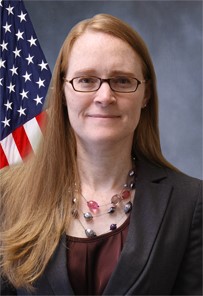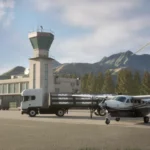Angela Stubblefield, the FAA’s senior representative in UK, outlines the five trends the administration expects to see in 2024.
 1. Air traffic increase
1. Air traffic increase
The number one trend is the rebound and continued increase in air traffic. We’re seeing in the US and other countries a return to pre-pandemic levels and even exceeding that in some cases. The ability to manage that increase safely and efficiently, and with the addition of new airspace users, is the first and foremost thing we’ll continue to see next year.
We need to look at how we continue to build on the safety record we have. Over the last 6-9 months we have seen some serious close call incidents that from our perspective are unacceptable – one is one too many – but it is a relevant reminder that safety is a journey of continuous improvement, you have to stay on top of it and there is no place for complacency.
Collaboration is key. The FAA runs the national airspace, but we have to work with airspace users, the airlines, general aviation, airports, every part of the ecosystem has a role to play in maintaining a safe and efficient system. This includes ensuring we have sufficient air traffic controllers. We met our hiring goal for 2023 and we’re increasing that goal for 2024. We’re also looking at technology in terms of the surface safety capabilities that are out there – we’re looking at what tech can be brought to areas that need it and what funding is available to airports to acquire that technology.
Information exchange is incredibly important too, both in the US but also with our international partners, to understand common trends. The more data we have, the better picture we have of those risks and how we can work together to eliminate risk.
2. Advanced air mobility
Advanced air mobility (AAM) has probably been the biggest surprise of 2023. The continued advancement and proliferation of companies getting into AAM and the different aircraft designs that we’re seeing come forward are very exciting.
Bringing this new sector of aviation to the skies is a huge undertaking, and we’re using the regulations we have in place to determine how these aircraft can meet our safety standards in innovative ways to maintain the high level of safety that defines commercial aviation today.
We’re doing it ‘project by project’ because these platforms differ substantially in terms of design and propulsion. As we work to certify more AAM aircraft, we’re also looking to pilot qualifications, the operational procedures, the airspace procedures to enable them to fly, as well as the infrastructure requirements. We’re working across all of those elements so that when we do get aircraft certified, all of those other elements are ready to accept them. 2024 is a huge year for all those aspects because in 2025 we will likely see aircraft that are ready to fly, and we want to make sure that they are able to do so.
3. Commercial space
Another trend we’ll see is the continued increase in pace of commercial space launches in the US and internationally. We’re on track to hit over 100 licensed US space launches in 2023 and we expect that to expand even further next year.
In the US, we’ve had over 600 licensed launches since 1989; we’ve learned a lot of very hard lessons. We’re having a lot of discussions with other international partners who are looking to grow their commercial space sector. We’re taking to them about our regulatory regime and why we do things the way we do – we have a long track record and a lot of expertise that we’re hoping to share.
It is like the AAM market – the convergence and transferability of licensing processes to create a common approach that will help advance safe launch operations for these commercial space companies will be key moving forward.
4. Sustainability
Sustainability is a massive trend for 2024 and the industry will be maintaining a strong focus on sustainability – in particular sustainable aviation fuel (SAF) use and production. We were very pleased to see the commitments that came out of the 41st assembly last year in terms of CORSIA and the long-term aspirational goal of the net zero emissions by 2050.
We’re going to be at 2024 very shortly and it feels like there is a long runway but with so much to do, particularly around increasing the production and availability of SAF, there is no time to waste. New entrants are also going to be able to contribute positively to the reduction in emissions given the electrification of AAM aircraft, hydrogen developments and so on, but there still isn’t time to waste.
The Conference on Aviation Alternative Fuels and COP28 this month in Dubai will help keep sustainability in focus and build the momentum.
In the USA, we think SAF is the key to getting the biggest near term reduction in emissions and we’re putting a lot of effort into that from a research support and incentive perspective – we’ve set a goal of having 10% aviation fuel demand met by SAF in 2030. However, if you look at that year on year, we have to make significant gains to get to where we need to be to meet the full demand projected by 2050.
We also have several programmes related to the efficiency of aircraft. We’re working with NASA on a sustainable flight partnership that looks to accelerate the development of more efficient aircraft engine technologies. We expect we could get upwards of a 30% improvement in fuel savings over the aircraft that are flying today, and you also get a reduction in noise as well which is another environmental benefit.
Innovative air traffic control procedures involving performance-based navigation, optimised profile descents, and other tools can provide more optimised trajectories that improve the efficiency of fuel usage, which will be key. It really is a multi-prong effort, and we need to work collaboratively to ensure we make aviation as efficient as possible.
5. Workforce
And the final piece is workforce, which is something the industry is struggling with on a global scale. Looking for ways to attract people into the aviation system, as well as use technologies to train them more efficiently, is a focus. The current and coming generations are more tech savvy and they have an expectation of those tools and are looking for environments that have a high level of technical capabilities.
When you bring in things like electrification, hydrogen and commercial space, there are a lot of new skills and capabilities that you want to attract as well. Beyond the aerospace engineers that we will always need, we’ll also require software engineers, experts in these novel fuels and propulsion systems, so it is exciting but presents a challenge.
We also need to look at creating a diverse workforce, so exploring how we reach those underserved, underrepresented populations who may not think aviation is a place where they can have a career will continue to be a big focus. There’s not only room for everyone, but there is also a need for everyone and all kinds of skillsets.

